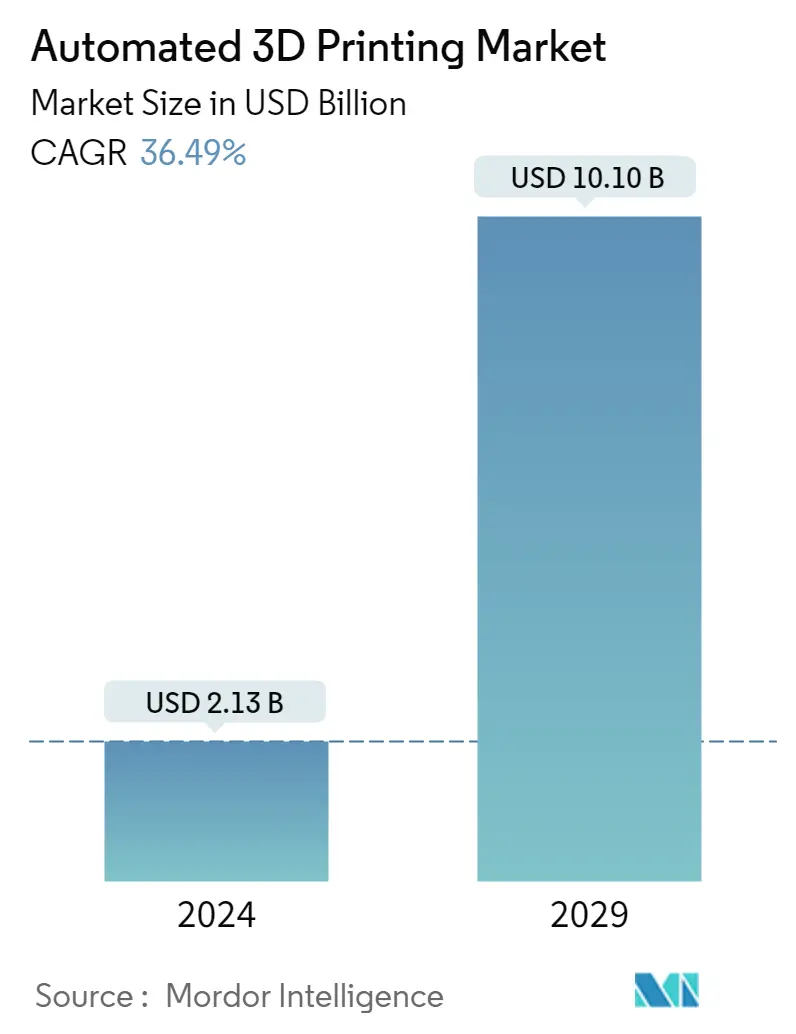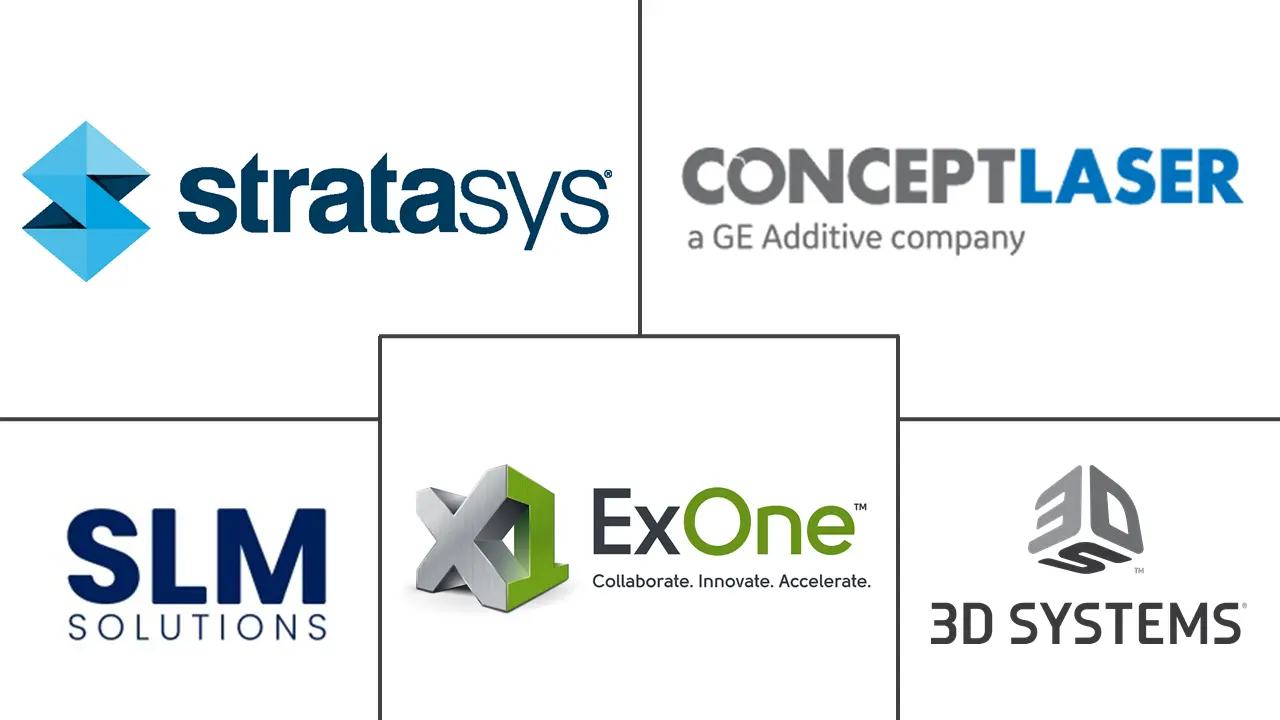Market Size of Automated 3D Printing Industry

| Study Period | 2019 - 2029 |
| Market Size (2024) | USD 2.13 Billion |
| Market Size (2029) | USD 10.10 Billion |
| CAGR (2024 - 2029) | 36.49 % |
| Fastest Growing Market | Europe |
| Largest Market | North America |
| Market Concentration | Medium |
Major Players
*Disclaimer: Major Players sorted in no particular order |
Automated 3D Printing Market Analysis
The Automated 3D Printing Market size is estimated at USD 2.13 billion in 2024, and is expected to reach USD 10.10 billion by 2029, growing at a CAGR of 36.49% during the forecast period (2024-2029).
The increasing investments in R&D and growth in the adoption of robotics for industrial automation are expected to propel market growth.
- Over the last few years, 3D printing has constantly experienced a shift from the prototyping and small batches phase to mass production technology with a growing adoption rate across the industries, where the industrial and non-printer vendors have shifted their focus toward automation. Also, with the evolutionary trend for additive manufacturing, hardware growing beyond stand-alone systems that are used for prototyping, tooling, and single-part production to be used as core systems within integrated digital mass production lines is driving the number of opportunities in the emerging lights-out factories.
- Artificial Intelligence and machine learning technologies are finding their way through various applications in the additive manufacturing industry. For instance, researchers from MIT have applied the data-driven nature of machine learning to automate the process of discovering new 3D printing materials. With machine learning, material performance factors, such as toughness and compression strength, were optimized using an algorithm that quickly outperformed conventional methods of 3D printing material formulation. The researchers developed a free, open-source materials optimization platform called AutoOED, allowing other researchers to conduct their material optimization.
- Similarly, in January 2022, a group of organizations from Germany and Canada formed a new collaboration to use 3D printing and AI to automate the process of fixing parts. The Artificial Intelligence Enhancement of Process Sensing for Adaptive Laser Additive Manufacturing (AI-SLAM) project aims to create powerful AI-based software that can run directed energy deposition (DED) 3D printers automatically. To more successfully repair uneven surfaces on damaged components, the software will algorithmically regulate the printing process. The Fraunhofer Institute for Laser Technology (ILT) and a software company BCT are part of the German consortium. In Canada, the work will be overseen by the National Research Council of Canada (NRC). McGill University will coordinate the research, and machine learning firm Braintoy will help program the AI models.
- Furthermore, there have been various developments in the market by players to enhance their position in the market. For instance, in April 2021, Mosaic launched Array, an automated 3D printing platform, which loads and unloads materials for its four Element HT printers, starts prints, removes prints, and stores them so that the next prints can begin. The Array is designed for maximum flexibility with its vending machine-style robotic arm that removes prints, places them to the side, and loads a clean bed for the next print, ensuring maximum output.
- In October 2021, 3DQue, a Vancouver-based developer of automation technology for the 3D printing industry, announced the launch of two new Quinly automation kits for the Creality CR-10 and CR-6 SE. Quinly is a virtual 3D printer operator served by a Raspberry Pi, a hardware and software kit capable of running desktop 3D printers on its own. The technology is designed to make 3D printing more scalable by taking manual labor out of the equation. It is primarily aimed at print labs, on-demand manufacturers, educational institutions, and anyone else seeking automated mass part production.
- Additionally, due to the disruption of supply chains and new demands for treatments and materials, the COVID-19 pandemic has significantly accelerated technological advancements in the pharmaceutical, medical device, and manufacturing sectors. The supply chain shortages have made it hard for medical personnel to get the supplies they need, generating a shortage of personal protection equipment (PPE) and medical devices in hospitals for fighting off the virus. Owing to this, additive manufacturing (AM) (automated 3D printing) has emerged as one remarkable fabrication process because of its accessibility and flexibility to produce complex and monolithic parts or even mechanical systems quickly.
Automated 3D Printing Industry Segmentation
The automated 3D printing market is segmented by offering (hardware, software, and services), process (automated production, material handling, part handling, post-processing, and multiprocessing), end user (industrial manufacturing, automotive, aerospace and defense, consumer products, healthcare, and energy), and geography.
Automated 3D printing refers to the application of technologies such as robotics arms or any other electronic systems to perform 3D printing tasks in environments that are either critical or tedious for human intervention, thereby end-users both monetary and operational efficiencies. The reports cover the emerging trends in automated 3D printing segmented by offering, process, and end-user verticals across different regions studied.
| Offering | |
| Hardware | |
| Software | |
| Services |
| Process | |
| Automated Production | |
| Material Handling | |
| Part Handling | |
| Post-Processing | |
| Multiprocessing |
| End-user Vertical | |
| Industrial Manufacturing | |
| Automotive | |
| Aerospace and Defense | |
| Consumer Products | |
| Healthcare | |
| Energy | |
| Other End-user Verticals |
| Geography | |
| North America | |
| Europe | |
| Asia Pacific | |
| Latin America | |
| Middle-East and Africa |
Automated 3D Printing Market Size Summary
The automated 3D printing market is poised for significant growth, driven by advancements in robotics and artificial intelligence, which are enhancing the capabilities and efficiency of additive manufacturing processes. The industry is witnessing a transition from traditional prototyping and small batch production to mass production, with a focus on integrating 3D printing into digital mass production lines. This shift is creating new opportunities, particularly in the development of lights-out factories, where automation minimizes human intervention. The adoption of AI and machine learning is further propelling the market, as these technologies are being used to optimize material performance and automate complex manufacturing processes. Collaborations and innovations, such as those seen in projects like AI-SLAM and platforms like AutoOED, are indicative of the industry's commitment to leveraging technology for improved efficiency and scalability.
The market is also experiencing a surge in demand across various sectors, including automotive, aerospace, and healthcare, where the need for rapid prototyping and flexible manufacturing solutions is paramount. The automotive industry, in particular, is embracing automated 3D printing for producing molds, tooling, and even end-use parts, which helps reduce costs and streamline production processes. The COVID-19 pandemic has accelerated this trend, highlighting the importance of additive manufacturing in addressing supply chain disruptions and meeting urgent demands for medical supplies. North America, with its robust presence of 3D printing vendors and technological advancements, remains a key market. Companies are investing in R&D and expanding their facilities to meet the growing demand, while also focusing on protecting intellectual property and enhancing the scalability of metal additive manufacturing applications.
Automated 3D Printing Market Size - Table of Contents
-
1. MARKET INSIGHTS
-
1.1 Market Overview
-
1.2 Industry Value Chain Analysis
-
1.3 Industry Attractiveness - Porter's Five Forces Analysis
-
1.3.1 Threat of New Entrants
-
1.3.2 Bargaining Power of Buyers
-
1.3.3 Bargaining Power of Suppliers
-
1.3.4 Threat of Substitute Products
-
1.3.5 Intensity of Competitive Rivalry
-
-
1.4 Assestment of the Impact of COVID-19 on the Industry
-
-
2. MARKET SEGMENTATION
-
2.1 Offering
-
2.1.1 Hardware
-
2.1.2 Software
-
2.1.3 Services
-
-
2.2 Process
-
2.2.1 Automated Production
-
2.2.2 Material Handling
-
2.2.3 Part Handling
-
2.2.4 Post-Processing
-
2.2.5 Multiprocessing
-
-
2.3 End-user Vertical
-
2.3.1 Industrial Manufacturing
-
2.3.2 Automotive
-
2.3.3 Aerospace and Defense
-
2.3.4 Consumer Products
-
2.3.5 Healthcare
-
2.3.6 Energy
-
2.3.7 Other End-user Verticals
-
-
2.4 Geography
-
2.4.1 North America
-
2.4.2 Europe
-
2.4.3 Asia Pacific
-
2.4.4 Latin America
-
2.4.5 Middle-East and Africa
-
-
Automated 3D Printing Market Size FAQs
How big is the Automated 3D Printing Market?
The Automated 3D Printing Market size is expected to reach USD 2.13 billion in 2024 and grow at a CAGR of 36.49% to reach USD 10.10 billion by 2029.
What is the current Automated 3D Printing Market size?
In 2024, the Automated 3D Printing Market size is expected to reach USD 2.13 billion.

